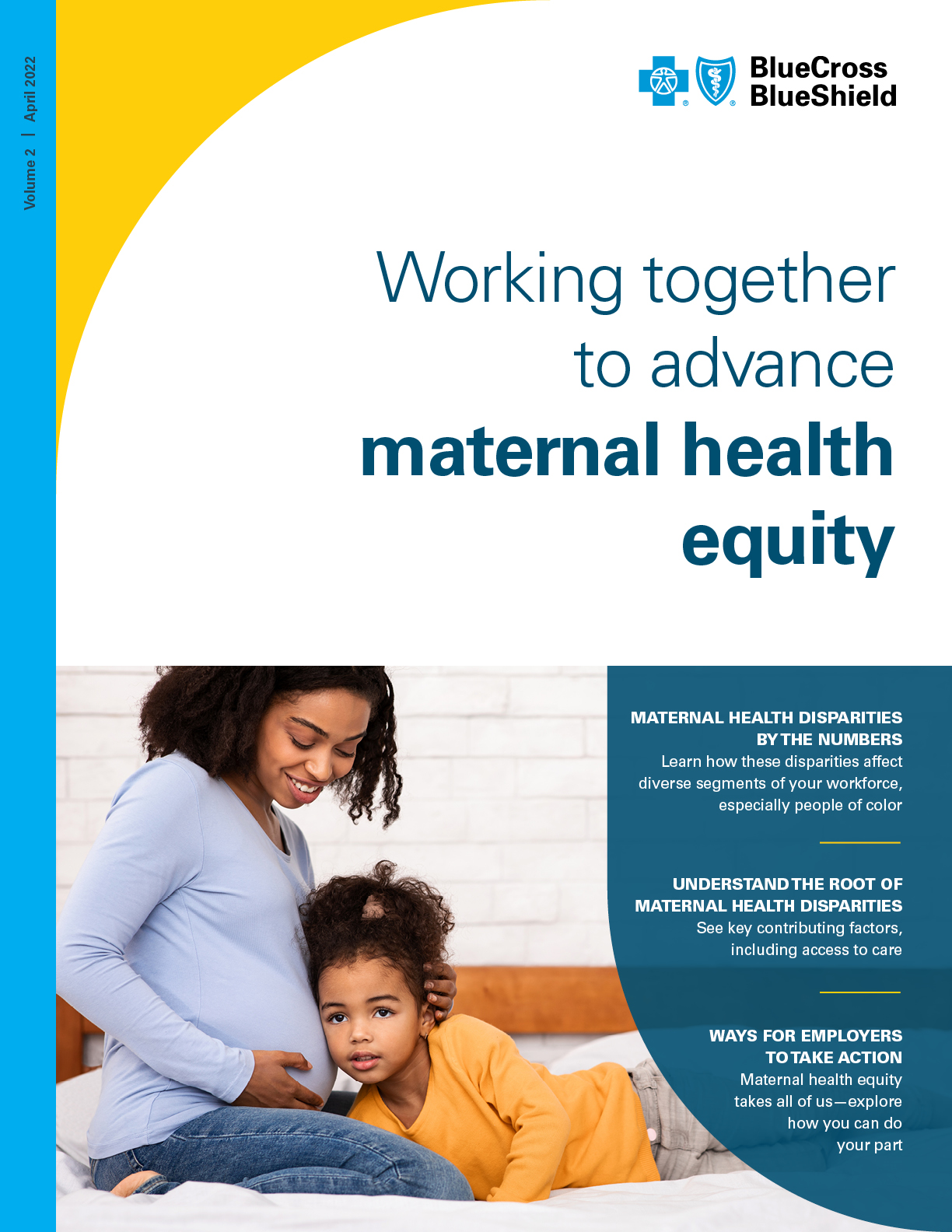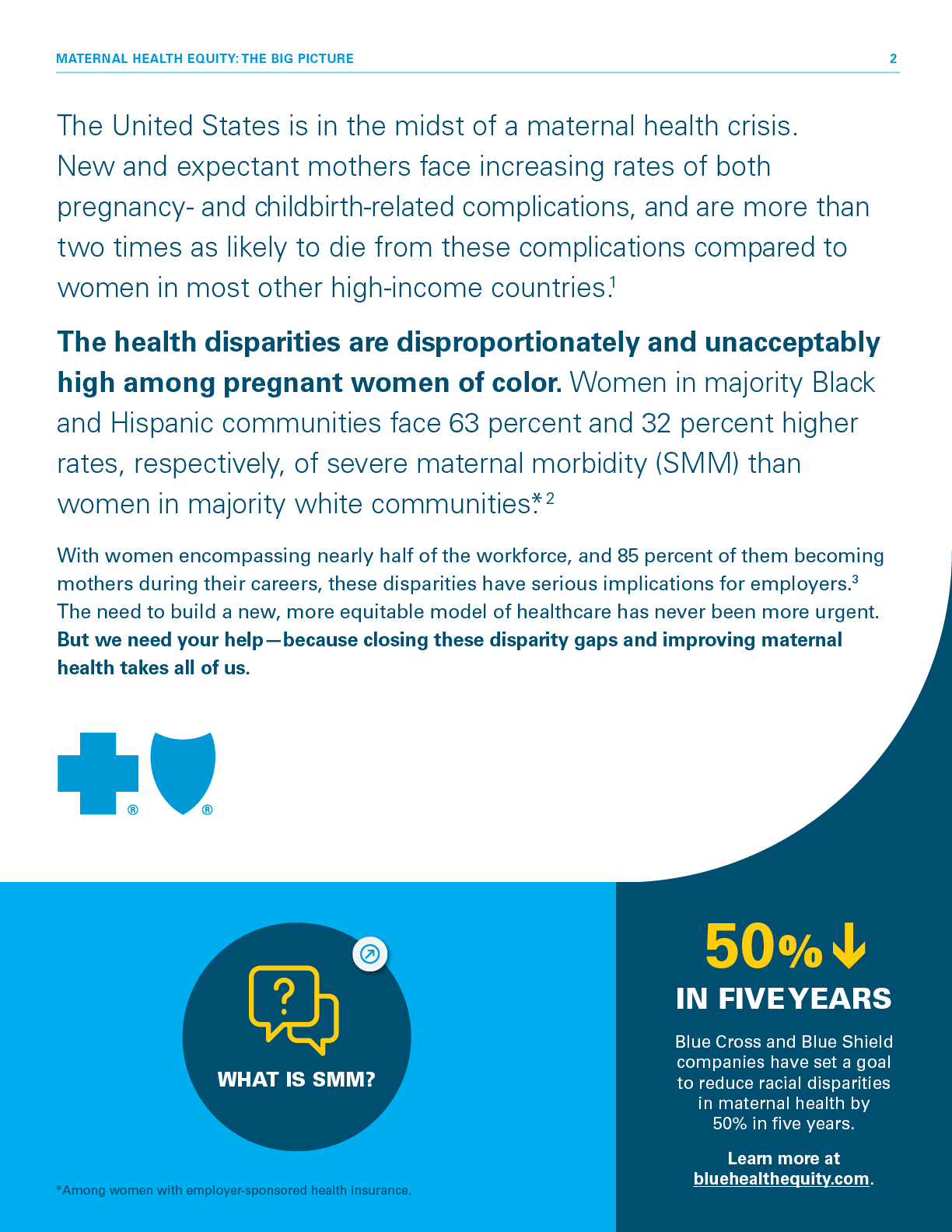Working Together to Advance Maternal Health Equity
Use Adobe Viewer for optimal experience.


Working together to advance maternal health equity
The United States is in the midst of a maternal health crisis. New and expectant mothers face increasing rates of both pregnancy and childbirth-related complications, and are more than two times as likely to die from these complications compared to women in most other high-income countries.
The health disparities are disproportionately and unacceptably high among pregnant women of color. Women in majority Black and Hispanic communities face 63 percent and 32 percent higher rates, respectively, of severe maternal morbidity (SMM) than women in majority white communities.
With women encompassing nearly half of the workforce, and 85 percent of them becoming mothers during their careers, these disparities have serious implications for employers. The need to build a new, more equitable model of healthcare has never been more urgent. But we need your help—because closing these disparity gaps and improving maternal health takes all of us.
WHAT IS SMM? *Among women with employer-sponsored health insurance. Severe maternal morbidity, or SMM, measures unexpected outcomes from labor and delivery with significant short- or long-term consequences to a woman’s health.
50% N FIVE YEARS Blue Cross and Blue Shield companies have set a goal to reduce racial disparities in maternal health by 50% in five years.
Maternal health equity: scale of impact
Grasping the extent of maternal health disparities is the first step in being able to provide support to expectant mothers in your workforce.
- PRECONCEPTION
- PREGNANCY
- LABOR & DELIVERY
- POSTPARTUM
Impact on employers
A majority of women in the workplace will become mothers during their careers, and 50,000 women suffer life-threatening pregnancy complications each year. These risks are especially high for women of color. This can have a huge impact on the health and overall well-being of your employees, their families and your business.
- 1.9M DELIVERIES PER YEAR
- OVER $1B IN SAVINGS
Understanding maternal health disparities
When addressing the many complex, interrelated reasons for maternal health disparities, it’s important to understand the impact of social determinants of health (SDoH) on health equity and how they affect maternal health. To learn more about SDoH and explore some overarching factors influencing health equity, check out our first Health Equity mini-eMagazine. Below are a few more key influencing factors.
Provider bias and inequality of care
Healthcare providers can have both conscious and unconscious bias when treating people of different backgrounds. Approximately a third of Black people report being racially discriminated against when going to a doctor or health clinic.24 A BCBS survey showed that as compared to white and Hispanic mothers, Black mothers report feeling their provider did not spend enough time with them, have lower confidence they will receive the care they need and feel like they cannot openly speak to their provider about their pregnancy.
Lack of access to care
People of color have less access to quality care from contraception to postpartum. Regular prenatal care can reduce the risk of pregnancy complications. In addition, compared with white mothers, mothers of color say they were not always able to complete the recommended series of prenatal visits, mainly because of a lack of transportation or scheduling conflicts. Furthermore, Black mothers are more likely to face greater financial barriers to care than white mothers. COVID-19, which disproportionately affects people of color, has also played a role in reducing prenatal visits. Chronic conditions and weathering Women in communities of color face much higher prevalence rates of underlying chronic conditions that are risk factors for SMM, such as preexisting diabetes (Black 62 percent, Hispanic 38 percent) and anemia, than women in majority white communities. Women of color also experience “weathering,” or an increased vulnerability to health risks due to the constant stress of encountering racism. This makes pregnancy riskier, as experiencing racism and prenatal stress are linked to adverse birth outcomes, such as low birthweight and preterm delivery.
2 3 OUT OF pregnancy-related deaths are preventable.
Every mother deserves to have the best care, regardless of age, race, ethnicity and ZIP code.
– Kim A. Keck, President and CEO of the Blue Cross Blue Shield Association
What we can do together
Women with employer-sponsored health insurance account for over half of the annual pregnancies in the United States.34 This puts employers and health plan partners in a unique position to positively impact maternal health by exploring benefit design options, involving local communities and fostering a supportive and inclusive workplace culture.
- Explore expanding benefits and strengthening networks.
- Collaborate with communities
- Create culturally competent workplaces
IN ON HEALTH EQUITY:
Providing high-quality, affordable maternal care
To help address disparities and gaps in care, Blue Cross and Blue Shield companies’ Blue Distinction Centers for Maternity Care demonstrate expertise and a commitment to quality care for mothers and their babies. Blue Distinction Centers+ providers demonstrate more affordable care in addition to meeting established quality thresholds. These Centers also have a maternity care quality improvement program, a lower percentage of early elective deliveries (including 75 percent fewer early elective deliveries and a 24 percent lower cesarean section delivery rate), lower readmission rates and lower complication rates when compared to non-designated providers.
Championing community and care support for moms
To help address disproportionate mortality rates among mothers and children, especially in underserved communities, Blue Shield of California has launched a new maternal and infant health initiative that provides community-based resources, doulas and technology tools to transform support and care for expecting and new mothers and their babies. This effort is an example of Blue Shield of California’s commitment to addressing the ongoing racial health inequities that directly impact the health of mothers and infants. The goal of the program is to bring equitable maternity support for mothers through a high-tech, high-touch approach and collaboration with community-based organizations.
What are doulas? They’re trained but non-clinical partners to women, often supplementing care from doctors and midwives. There’s care for expecting and new mothers and evidence to suggest that working with a doula can reduce serious complications among women of color.
What are midwives? Certified nurse-midwives (CNMs) and certified midwives. The goal of the program (CMs) provide independent care during pregnancy, is to bring equitable maternity support for childbirth and the postpartum period; gynecologic health; and family approach and collaboration with community planning services, including preconception care.
Join the movement to advance maternal health equity
Have your only bias be for action
Consider the fact that women with employer-sponsored health insurance account for over half of the annual pregnancies in the United States, and you start to see the influence and impact employers can have in pushing for higher-quality care. Pursue ways to collaborate with your health plan partner to advance and expand maternal health equity across the care continuum.
Make workplaces safe spaces for expressing maternal health needs
One of the best ways to know what your workforce needs is to engage with them. Design ways to open dialogue and check in with employee populations of all types, and meet with Employee Resource Groups (ERGs) to share education on maternal health disparities. But most of all, listen to their needs and concerns, and respond with support.
Get everyone involved
Advancing maternal health equity requires a collaborative approach. Ask your health plan partner to see what solutions they can offer, and approach local communities for available resources. By working together, we can confront racial disparities in maternal healthcare and take actions that make pregnancy safer for all women.


